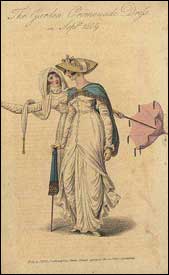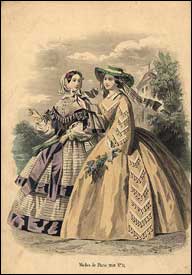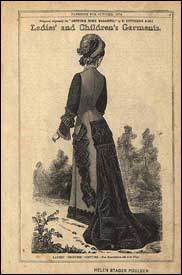Fashion Plate Collection
The original fashion plates collected by Blanche Payne and others have been cataloged and carefully stored for preservation purposes in archival housing. Many of these plates are from some of the leading French, British, American, and other continental fashion journals of the 19th century and early 20th century: Belle assemblée; Le bon ton; Le Follet, courrier des salons; Journal des dames and des modes; Godey's lady's book and magazine, and others. They are primarily hand-colored engravings although some of the plates after 1885 are colored lithographs. A project was undertaken by the Digital Initiatives Program to digitize and provide online access to selections from this collection. The 417 digital images cover many stylistic periods in French and English history. These include the Empire (1806-1813), Georgian (1806-1836), Regency (1811-1820), Romantic (1825-1850), Victorian (1837-1859), Late Victorian (1860-1900) and Edwardian (1901-1915). Although the original items are available for viewing by appointment through the Special Collections Division, providing web access increases the visibility and use of such unique resources.
Blanche Payne taught historic costume and apparel design in the School of Home Economics at the University of Washington. She joined the University faculty in 1927. Engaged in intensive research on clothing and historic costume, she supervised work on the Textile Costume Study Collection housed in the Home Economics Department. As part of her studies of non-Western folk dress and embroidery technique, she traveled extensively in Europe, collecting original ethnic costumes, textile and embroidery examples. Her primary interest was Eastern Europe. She considered the Balkan countries a valuable source for studying ethnic dress in its original context and wanted to provide her students with primary source material for the study of modern costume construction and fine craftsmanship. Unfortunately, her Yugoslavian research failed to result in a full length publication because of the prohibitive costs of publishing and destruction of some of the color plates during the war years.
One of her subsequent accomplishments, however, was the completion of a book entitled "History of Costume", a college textbook describing the evolution of fashion from 3000 B.C. to 1900. Published in 1965, it contains detailed descriptions of historical and cultural fashion along with renditions of small-scale garment patterns that she meticulously drafted from various museum collections. To research her book, she spent two years avidly collecting illustrations: photographs, postcards, art prints, and fashion plates. Her book is still considered today a foremost resource in the study of costume history. It reflects her teaching philosophy that the study of original artifacts is of essential importance in the understanding of good design.
Blanche Payne retired from the University of Washington faculty in 1966. The textile and ethnic dress samples she purchased from funds from the School of Home Economics were bequeathed to the Henry Art Gallery Textile Collection. Her collection of costume and textile books, as well as the archival photographic material, fashion plates, drawing and garment patterns she researched for her publications remain as part of the UW Libraries Manuscripts, Special Collections, University Archives. Manuscripts relating to the Eastern European costume, including her travel journal through the Balkan countries and notes for her book "History of Costume" are also available to researchers through the University Archives.
Plate 1: Empire period fashion. Garden Promenade dresses for November 1809. They reflect the Empire style. The fashion trend in the late years of the 18th and early 19th centuries was influenced by Classical Greece: high waisted gowns with long thin muslin skirts and long stoles. In the foreground the figure sports such details as: a shawl mantelet in purple silk, trimmed with a rich silk amber coloured fringe, fastened on the bosom with a pebble brooch, amber hoop earrings, shoes of white Morocco; gloves of York tan; parasol purple shot and fringed with amber. The figure in the back represents a lady with a Nun's hood thrown carelessly round the head, and falling in graceful negligence over the shoulders. (Original source: La Belle assemblee, vol. 7, no. 51)
Plate 2: Georgian period fashion. Evening and walking dress for December 1827 By the 1820s, fashion had changed from the flowing Classical style to tightly corseted waists, full sleeves gathered to a fitting cuff, and fuller skirts. The headdress and scarf on the left are lavishly described as: a Vienna toque, consisting of separate stiffened puffs of pink satin. It is ornamented with very short white curled feathers, placed in various directions, and peeping out amongst the puffs, as though they were merely the tips of feathers. One long loop of pink gauze ribbon, richly brocaded, depends from this elegant head-dress, over the left shoulder. A drapery scarf is sometimes added to this dress, of white barege, with the ends in stripes of gold across, and finished by a splendid and gossamer-like fringe of white silk. (Original source: La Belle assemblee, new ser., vol. 7, no. 36.)
Plate 3: Victorian period fashion. Promenade dresses for 1858. Crinolines made from hoops of whalebone covered with layers of flounced petticoats were introduced in the 1840s-1850s reaching greatest popularity around 1860. Sleeves were worn wider and shorter, often with a muslin, sometimes puffed, undersleeve. Notice the bell-shaped sleeves and variety of hats and bonnets popular during this period. (Source: Modes de Paris. 1858)
Plate 4: Late Victorian period fashion. Walking dress for October 1876. In the 1870s dress shapes changed--the front and sides were flattened while the bustle or fullness was retained at the back using a horsehair crinoline with whalebone or metal bands. The bustle was worn under petticoats and a gown often looped up in elaborate folds at the back. The gown illustrated is elaborately described: To the lower portion of the back is attached a [silk] puff and from the bottom of the puff falls a full back-breadth, each being so gathered at the upper edge that a ruffle is formed. The pocket ... is of [silk], while the lap is of plain silk; both are edged with lace and a handsome bow completes the point. (Original source: Arthur's illustrated home magazine. October 1876)
Plate 5: Edwardian period fashion. Dress with tunic for 1914. By 1909, the straighter sheath line silhouette replaced the fuller skirts of the previous century. Paul Poiret, a prominent French dress designer, introduced Oriental-influenced fashion. Kimono or Magyar style sleeves, turban headwear, Turkish or harem skirts and tunic overdresses with large armholes, open to hip level, were common. Illustrated is an embossed velvet evening coat with kimono sleeves trimmed with silver silk brocade. (Original source: Journal des dames et des modes, supplement, vol. 4, no. 61, February 1, 1914)
Other sources
Payne, Blanche. The history of costume : from ancient Mesopotamia through the twentieth century / Blanche Payne, Geitel Winakor, Jane Farrell-Beck ; drawings by Elizabeth Curtis. New York, NY : HarperCollins, c1992
Payne, Blanche. "Some costumes of Yugoslavia". Bulletin of the Needle and Bobbin Club, Vol. 41, 1957
About the Database
The information for Fashion Plate Collection was researched and prepared by the UW Libraries Special Collections and Cataloging staff in 2002. Not all the plates from the collection were included in this database: the database consists of 417 digital images chosen from a larger group of fashion plates. The images were scanned in color using a Microtek Scanmaker 9600L and saved in .jpg format. Some manipulation of the images was done to present the clearest possible digital image. The scanned images were then linked with descriptive data using the UW Content program. The original collection resides in the UW Libraries Special Collections Division as the Fashion Plate Collection.






